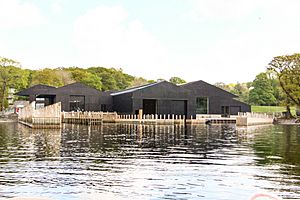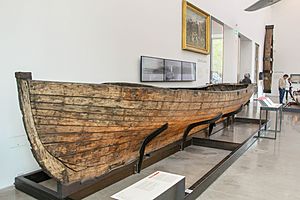Windermere Jetty: Museum of Boats, Steam and Stories facts for kids
 |
|

Windermere Jetty from the water
|
|
| Lua error in Module:Location_map at line 420: attempt to index field 'wikibase' (a nil value). | |
| Former name | Windermere Steamboat Museum |
|---|---|
| Established | 1977 |
| Location | Windermere, Cumbria |
| Key holdings | Steamboats and yachts |
| Founder | George Pattinson |
The Windermere Jetty: Museum of Boats, Steam and Stories is a cool museum in Cumbria, England. It sits right on the eastern shore of Windermere, a famous lake. This museum is all about boats, especially old steam-powered ones, and the interesting stories behind them. It used to be called the Windermere Steamboat Museum. After being closed for 12 years for big updates, it reopened its doors in March 2019.
Contents
Discovering the Museum's History
The Windermere Steamboat Museum first opened in 1977. It was built on what used to be a sand and gravel wharf. The museum started with a special collection of boats gathered by George Pattinson, a local builder who loved collecting boats. A charity called the Windermere Nautical Trust ran the museum.
The original museum had many important boats. These included old steamboats, motorboats, and yachts. One very special boat was SL Dolly, built around 1850. It's known as the oldest boat in the world that still works with its original engine! The museum also had beautiful steam launches. SL Branksome (from 1896) was super fancy with velvet seats. SL Raven (from 1871) was a cargo ship that carried coal around the lake. TSSY Esperance (from 1869) was used by Henry Schneider to travel to work. Many of these steamboats could still float and work perfectly!
In 2007, the museum closed to the public. Another local charity, Lakeland Arts, took it over. This charity also manages other cool places like the Abbot Hall Art Gallery. Eleven of George Pattinson's boats were given to Lakeland Arts in 2007. Then, in 2009, the Windermere Nautical Trust joined forces with Lakeland Arts.
Reopening as Windermere Jetty
In 2011, Lakeland Arts announced plans to build new museum buildings. These new buildings would keep the boats safe and have a special workshop. In this workshop, experts could fix and look after the old boats. The famous architects Carmody Groarke designed the new museum. It reopened in March 2019 with its new name, "Windermere Jetty: Museum of Boats, Steam and Stories." Prince Charles even attended the official opening ceremony in April 2019!
The museum also appeared on the BBC One show Antiques Roadshow in February 2021. The episode was filmed there in 2020.
Amazing Boats in the Collection
The Windermere Jetty Museum has about 40 boats! They show the history of boats on Windermere, from the late 1700s to today. These include steam launches, sailing boats, and other types of vessels. Four of the museum's boats are so important that they are part of the National Historic Fleet.
Here are some of the special boats you can see:
- Steam launch Branksome was first called Lily when it was built in 1896. It's made of teak wood and still has its original steam engine. The inside was very luxurious, with velvet seats and walnut wood. It even has a "Windermere kettle," which used steam to boil water super fast for tea! This boat is about 50 feet long and 9 feet wide. You can see it inside the museum building.
- Steam launch Dolly was built in 1850 and still has its original engine. It's a very rare example of an early steam launch. It's even listed in the Guinness Book of Records as the oldest working boat with its original machinery! Dolly has a wooden hull, and no one knows who built it. It sank in 1895 but was brought back up in 1960. It might have been the first boat on Windermere to use a propeller instead of paddle wheels. It's about 41 feet long and 6.5 feet wide. You can also see Dolly inside the museum.
- Steam launch Esperance was built in Scotland in 1869 from wrought iron. It came to Windermere by train in 1870. It was built very well, with smooth hull plates. It had two steam engines. Its first owner, Henry Schneider, used it to start his commute to work. He would take the boat to the train station at Lakeside. In the 1920s, it became a houseboat. This boat even inspired Captain Flint's houseboat in the famous book Swallows and Amazons! Esperance is about 65 feet long and 10 feet wide.
- The steam barge Raven was built in Scotland in 1871. The Furness Railway Company used it to deliver goods all over the lake. It has an iron hull and its original single-cylinder steam engine. Raven is about 71 feet long and 14.5 feet wide.
The Museum Buildings
The new museum buildings were designed by Carmody Groarke architects and Arup engineers. A cool thing about the buildings is their outside walls. They are covered in special copper that has turned an interesting reddish-brown color over time.
Awards for the Museum Buildings
In 2021, the Windermere Jetty Museum was one of six buildings chosen for the important Stirling Prize. This award celebrates the best new buildings in the UK. The museum also won several other awards in 2021, including the RIBA North West Award and the RIBA North West Building of the Year Award.




